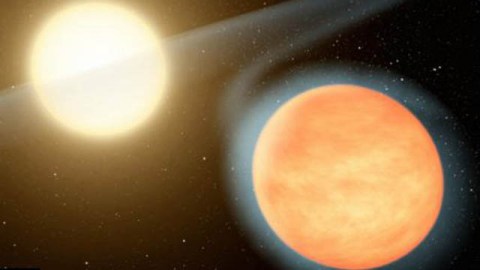Scientists Discover the First Carbon-Rich Planet—Which May Have Mountains of Diamonds

On the 9th of December, Astronomers Madhusudhan, Harrington and colleagues recently discovered a massive gas giant planet, orbiting a star which they have coined the first carbon-rich world ever observed. The planet, called WASP-12b was observed with NASA’s Spitzer Space Telescope, using a technique in astronomy circles called a secondary eclipse (when the planet is blocked by its star). The planet itself was discovered last year but this new discovery has successfully assessed its atmosphere, proving that this is the first planet discovered that has the carbon-to-oxygen ratios reversed. This most recent discovery was built upon previously studies from ground-based operations and it is a game changer for future observations.
You are probably wondering how they come up with the names for these planets. Well, WASP-12b is an acronym which stands for Wide Angle Search for Planets. It’s about 1.4 to 1.5 as large as planet Jupiter and it’s location is approximately 1,200 light years from Earth. However, unlike most planets; WASP-12b is not round. In fact, it’s own star’s gravity stretches it into an egg shape; The star’s massive gravity is also sucking mass off of WASP-12b which orbits currently around the carbon-rich planet. JPL recently stated that astronomers don’t currently have the technology to observe the cores of exoplanets, or planets orbiting beyond our sun, but their theories hint at these intriguing possibilities.
The exoplanet however is thought to be far away from supporting any kind of life and is, in fact, one the hottest exoplanets we have found to date. In terms of temperature, the side that faces its sun is scorching at over 4,000 degrees Fahrenheit. But NASA’s recent announcement on astrobiology and how bacterium can thrive in an environment of arsenic has everyone singing a different tune these days of how adaptive life really is. As I have stated in previously interviews about this astrobiology announcement: all biology textbooks across the globe now have to be revised. Another interesting feature is how fast this planet travels. Earth for example takes 365 days to make a trip around the sun while WASP-12b screams around its sun in about a day.
Team member Madhusudhan stated in a telephone interview with Bloomberg.com that “Like Jupiter, WASP-12b is made largely of gas, only it’s core contains carbon-based minerals such as diamonds and graphite.” Yes, this means that there could be mountain sized chunks of diamonds, but I suppose that they aren’t worth much considering that they are over 1,000 light years away. What’s most interesting about the discovery of a carbon-rich planet is that it suggests that our universe may be teeming with them (this we can only assume, as this is the first one, but it’s a safe bet). We are already aware that carbon basically forms the entire backbone of biology for the vast majority of life here on Earth. Carbon is a versatile element when it comes to the “chemistry of life, are that it has four valence bonds and that the energy required to make or break a bond is just at an appropriate level for building molecules which are not only stable, but also reactive. The fact that carbon atoms bond readily to other carbon atoms allows for the building of arbitrarily long and complex molecules.”
These new results are now throwing up lots of questions into how planets are formed and even how we hunt for them. What this team has discovered is something that has essentially never been seen before. Planet hunters generally assume that other planets should be similar to the planets in our own Solar System. Madhusudhan suggests that a plethora of different life forms might thrive on carbon-rich methane rather than water or oxygen, and that this planet reveals the astounding diversity of worlds out there.




